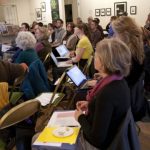HOW TO BUDGET AS AN ARTIST
Gain Confidence in Your Finances in 3 Easy Steps
For artists of all disciplines – painters, writers, actors, musicians, dancers and performers – sharing their creative practice and passion is essential to their overall success. Another crucial, yet less visible component is how they manage their finances.
Unfortunately, words like budgeting and taxes can fill creative professionals with fear and apprehension. If you’ve never kept to a strict budget before, knowing where to begin can be the first hurdle. Together we’ll review how to gain confidence in your finances in three easy steps:
1. Gain Awareness: Track your spending for a month
Without question, artistic practice and personal debts are connected. Falling behind on financial obligations like credit card bills and student loans can adversely affect your art. The first step to create a budget is to determine how much money you spend, and to whom you are paying that money. To do this, you will need to track your expenses, or spending, for at least a month, and the longer the better.
From NYFA’s book, The Profitable Artist, “Whatever your artistic goals, a budget will give you a clear-eyed look at your financial situation and will help you to analyze and shape your business model to best achieve your artistic goals.”
Save your receipts. Note how much you spend on art supplies. And don’t forget automated payments like student loans or credit card bills. Once you have a comprehensive picture of your expenses, you can identify changes that could make a big difference in your income.
2. Determine your Artist Rate: Break it down by hour, day and week
To make your life sustainable and financially successful, you must know your value to determine whether or not you can afford to participate in opportunities. Andrew Simonet, founder and director Artist U, has dedicated his life work to helping artists reach their full professional potential. In his book, Making Your Life as an Artist, he provides a step-by-step formula on how to determine your artist rate.
The first step is writing down the annual income you need to live without financial panic. It’s important to review your gross income from last year’s taxes, along w/ any monies earned that were not on your taxes. Next, using that number consider your financial activities: Were you strapped for cash? Did you have difficulty paying bills? Once you determine your annual income needs, you can figure out your hour, day, and week rates.
Excerpt from Making Your Life as an Artist:
Artists don’t know what our time costs. People ask us to do residencies, workshops, artist talks, etc., and to make our lives sustainable, we need to know our rates.
Take the annual income number you just figured out and divide it by 1,500 to get your hourly rate.
Why 1,500? If you work a “normal” job for a year, you’ll work 2,000 hours (40 hours per week for 50 weeks) Artists don’t have 2,000 hours to earn our living. A lot of our work is piecemeal, a teaching gig here and a day job there, with lots of prep, travel and transition time. And we need more down time than most people to feed our imagination and vision. Artists who earn their living in 1,500 hours find sustainability.
Once you have your hourly rate, multiply it by 8 to get your day rate (8 hours in a work day), and multiply your day rate by 5 to get your week rate.
Here’s an example. Suppose you decide you need to earn $45,000 per year to live without financial panic.
45,000 ÷ 1,500 = $30/hour
30 x 8 = $240/day
240 x 5 = $1200/week
These are internal numbers. You can ask for more and you can work for less. But knowing these numbers gives you a basis for pricing your time and negotiating.
Bonus: You can download the e-book here for free: http://www.artistsu.org/making/
3. Budget, Budget, Budget
When you create a budget, you set practical parameters for your basic needs and financial responsibilities. It’s an empowering tool that helps you develop long-term goals and make proactive career decisions. Should you rent that studio? Can you afford those head shots? You can begin to see how your money supports your artistic practice and sustains your livelihood. In The Artist’s Guide, Jackie Battenfield identifies three main categories for funding your art and your life:
- Earned Income – Wages, tips and salaries you receive from employment.
- Unearned income – Sources other than employment and profit from a business, such as interest from savings and stock dividends. For artists, unearned income can also come in the form of project grants, fellowships, and cash prizes.
- Other Support – Goods and services that don’t include cash, such as living accommodations during artist residencies or donations of materials.
It’s vital that you understand the distinctions above and ask yourself the following questions:
- Where do you currently get your support?
- Does it come from several categories or only one?
There are many online tools that artists can use to track their finances. For example, GoodBudget categorizes items, such as rental payments, groceries, and utilities, and tracks your spending all from your smartphone. As you begin to record your expenses it’s important to classify them correctly. A good habit to follow is using the categories on the IRS Schedule C and consider whether your expenses are cost of goods sold or the cost of services provided.
By prioritizing your finances, you can bring order to your personal life and grow your art career. Be inspired to action by using the financial resources from our database, NYFA Source by clicking on the “Services” menu and selecting “Business/Legal/Finance” for the drop-down menu.
As a complement to this post, check out Tax Time Roundup, which lists free financial counseling around the country.
Professional Development
Basic Finance for Artists – Lower Manhattan Cultural Center
New York, NY
Smart Money for Creatives Webinars – Arts Council of New Orleans
New Orleans, LA
Banking Services
New York, NY
The Lower East Side People’s Federal Credit Union
New York, NY
Musicians’ Interguild Credit Union
Los Angeles, CA
Legal Aid
Legal Workshops – Washington Area Lawyers for the Arts
Washington D.C.
Legal Workshops – Lawyers for the Creative Arts
Chicago, IL
Art Law Clinic – Maryland Lawyers for the Arts
Baltimore, MD
Lawyer Referral Services- California Lawyers for the Arts
Santa Monica, CA





